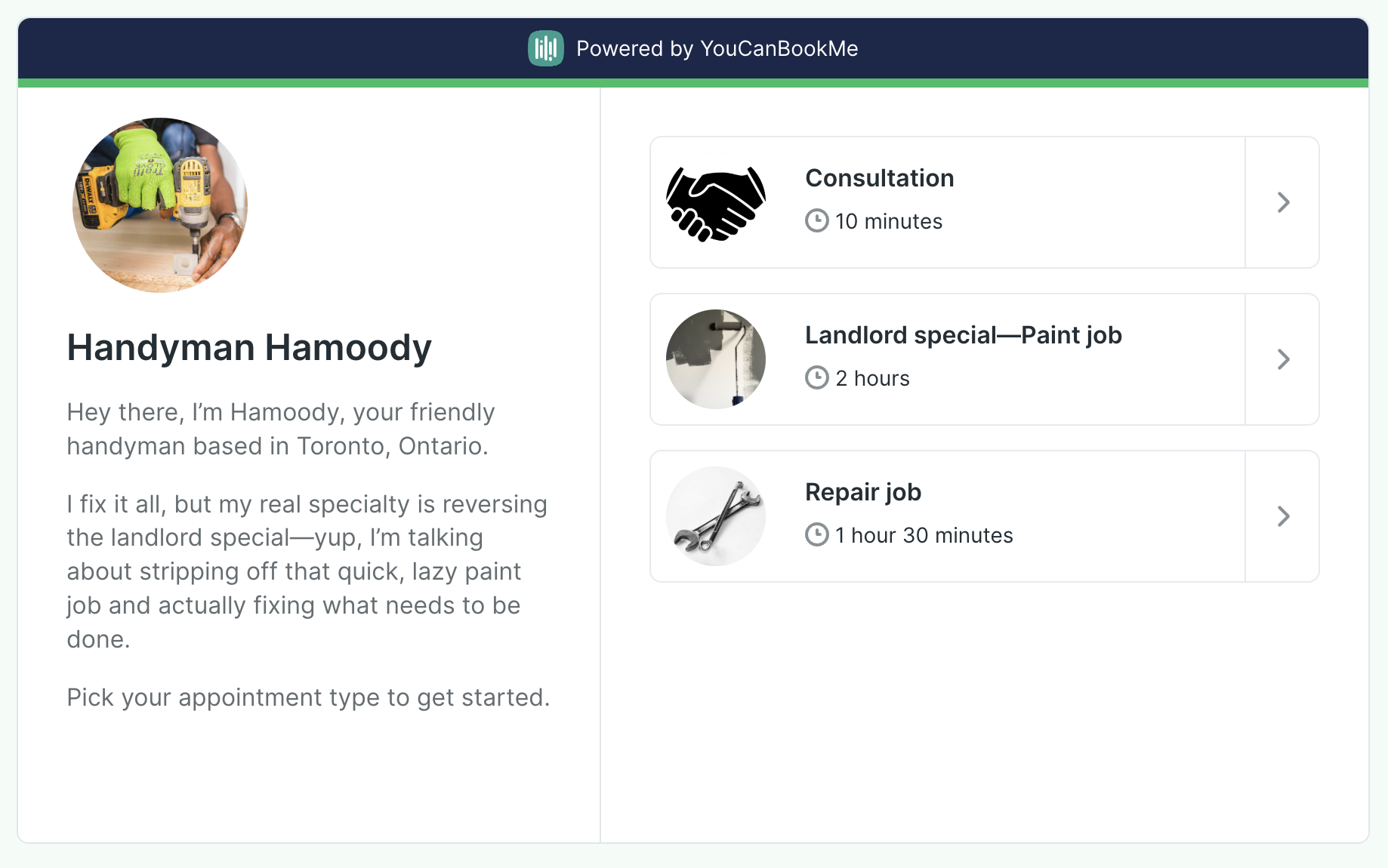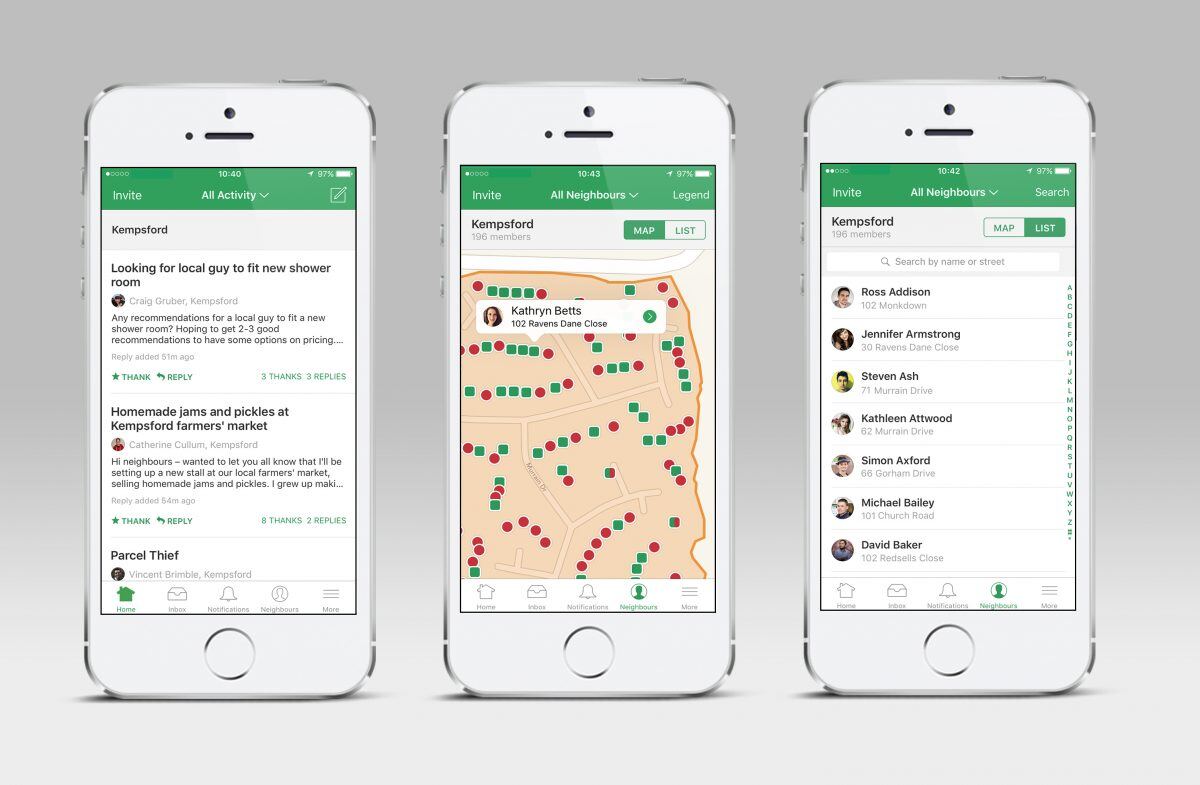How to Start a Handyman Business in 8 Easy Steps
Turn your skills into profit with this simple guide on how to start a handyman business.

Hannah Ouijdani
.jpg?width=1280&height=853&name=pexels-bidvine-517980-1249611%20(1).jpg)
Ready to book more meetings?

- Decide what services you want to offer
- Set up your business
- Identify your ideal customer
- Set your pricing
- Build your network
- Make it easy for prospective clients to book time with you
- Learn how to manage your business and client relationships
- Market yourself
- ✨Bonus✨Handyman Business Startup Checklist
Turn your skills into profit with this simple guide on how to start a handyman business.
Whether you’re tired of working for someone else or just looking to turn your hands-on skills into a thriving business, learning how to start a handyman business could be your path to freedom. From deciding on your services to marketing your business, this guide walks you through the essentials to help you get started.
Ready to dive in?
1. Decide what services you want to offer
You’re great at fixing things, but what exactly do you want to fix? The beauty of running a handyman business is the flexibility—you can offer a wide range of services or specialize in a few areas that excite you most.
Ask yourself:
- Do I enjoy small, quick fixes, or more involved projects?
- Would I rather focus on plumbing, electrical, or general home repairs?
- Do I want to work on residential properties, commercial spaces, or both?
You can then use these as lead qualification questions, ensuring each potential client aligns with your target customer. Remember that choosing your niche not only helps you stand out but also ensures you’re doing work you enjoy.
Once you know what you want to offer, consider creating a handyman business startup checklist to organize everything you need, from tools to licensing requirements. Psst…we’ve included one at the very end of this guide to make it even easier for you!
|
Tip from the experts 🔨 "I decide what jobs I want to take on and when. It’s absolutely freedom. Of course, there are tough days, but all in all, I would highly recommend it." |
2. Set up your business
Once you’ve decided on your services, it’s time to get the foundational pieces of your business in place. While the idea of setting up a business might sound overwhelming, starting a handyman business is easier than you think!
Here’s what you’ll need:
- Pick a business name: Choose something memorable that reflects your services. Keep in mind that your business name will go everywhere—on business cards, your website, flyers, online ads, your booking page, etc—so choose well!
- Register your business: Depending on where you’re located, you might ask, “Do I need a license to start a handyman business?” The answer depends on your state’s regulations. Some states require licensing for specific types of work (like electrical or plumbing), while others have more relaxed requirements.
- Get the right tools: You might need to invest in new tools depending on the services you offer. This will include actual physical tools (like the ones you’re familiar with), as well as online tools that’ll help you book clients and fill your calendar, like YouCanBookMe. Make sure you’ve got everything covered to avoid scrambling mid-job.

|
Important reminder 💼 |
3. Identify your ideal customer
Knowing who your ideal customers are can make marketing and service delivery so much smoother.
Are you the go-to for quick residential repairs, or do you cater more to commercial property managers juggling multiple buildings?
Defining your Ideal Customer Profile (ICP) early ensures you’re not wasting time trying to be everything to everyone. You’ll attract the right kind of clients who value what you offer—and are happy to pay for it!
Here’s how to get crystal clear on your ideal client 👇
Residential vs. commercial—Are you more comfortable fixing things in family homes, or do you see yourself handling maintenance for offices or apartment complexes? Residential clients might bring you smaller, frequent jobs like fixing a leaky faucet, while commercial clients could offer larger contracts for ongoing maintenance.- Homeowners usually need one-off, smaller repairs like patching drywall or installing light fixtures. These jobs are quick but can lead to steady referrals if you build strong relationships.
- Commercial property managers need regular, large-scale maintenance. This could mean a contract to service multiple buildings, handle renovations, or be on-call for emergencies. The jobs may be bigger and require more planning, but they can also be more lucrative with consistent, long-term income.
- Smaller, more frequent jobs can help you build a solid client base quickly. Think installing blinds, replacing door handles, or assembling furniture. They’re usually one-and-done, but they can lead to consistent work if you’re the type of handyman clients trust for any minor fix around the house.
- Larger projects, like kitchen remodels or ongoing property maintenance, may take more time and resources but can deliver higher payouts. They’re ideal if you prefer fewer clients but more in-depth work. If you enjoy seeing a project through from start to finish, these jobs will be more satisfying—and more financially rewarding.
Landlords vs. residential property owners—Do you want to build relationships with landlords or cater to individual homeowners?
- Landlords and property management companies often need a reliable handyman for multiple units, offering you repeat business and steady work. They may need someone to service multiple properties on a regular basis, from fixing small issues between tenants to handling larger renovations.
- Individual homeowners, on the other hand, tend to call for one-off jobs when something goes wrong. These smaller jobs can be easier to schedule around, but they may not offer the same consistency as working with a property manager. However, word of mouth is powerful among homeowners, and doing great work for one family can lead to plenty of referrals.
Next step—Targeted marketing that resonates
Once you’ve defined your ICP, marketing becomes much easier. Knowing exactly who you’re talking to means you can tailor your messaging to solve their specific problems. For example:
- Homeowners might appreciate ads that emphasize reliability, quick fixes, and trustworthiness. Highlight how you can take care of those nagging household repairs so they don’t have to.
- Commercial clients might be drawn to messaging about efficiency, long-term contracts, and a full-service offering. Focus on how you can be their one-stop-shop for property maintenance, saving them time and money.
The more targeted your marketing is, the more you’ll attract clients who are the right fit—and that means less time wasted chasing leads that go nowhere. It’s all about honing in on where you can deliver the most value!
4. Set your pricing
One of the trickiest parts of learning how to start a handyman business is figuring out how much to charge. Set your prices too low, and you won’t cover expenses. Too high, and you risk scaring off potential clients.
"I’m learning that charging by the job instead of by the hour is the way to go. Figuring out how much to charge for any particular job is often the most difficult part of it all. But as long as you know your worth, you’ll be styling." - Reddit user ieatdirt44
How to price your services
If you’re wondering how much it costs to start a handyman business, it will vary depending on your initial setup, tools, and marketing efforts. Keep an eye on these costs as you begin!
Setting your rates as a handyman isn’t just about your time on the job—it’s about covering all the little (and not-so-little) costs that keep your business running. From your truck to your tools, everything factors into what you charge. Here's how to break it down:
- Truck/vehicle: Don’t forget to account for maintenance, insurance, and wear and tear on your truck. A good starting point for calculating these costs is around $0.65–$0.75 per mile.
- Travel: Besides the truck itself, consider gas, parking, and the time spent driving. You can charge around $0.75 per mile to cover these expenses.
- Equipment: Whether it’s a power drill, saw, or ladder, your tools represent a serious investment. Factor in the cost of maintaining and replacing them. You’ve likely spent $2,500 or more on your essential gear.
- Materials: For most jobs, you’ll need to buy materials like nails, pipes, or tiles. Always calculate this in the job quote. Even something as small as replacing a faucet could mean spending $60 on parts.
- Labor: This is where your skill and experience come into play. In 2024, competitive handyman rates are between $80–$100 per hour, depending on your expertise and the job complexity.
- Marketing: Even if you’re just running Facebook ads or printing business cards, those costs add up. Budget around $60 per month for basic marketing efforts.

|
Pricing guide 🧰
Pro tip 🚀 Start by researching what other handymen in your area charge. Then, adjust based on your experience and the type of job. |
Sample cost breakdowns
Small job—Fixing a leaky faucet
Let’s break down the costs for a small job, like fixing a faucet. You’re not just charging for your time—you’re factoring in travel, equipment use, and materials too:
- Travel (10 miles round trip): $0.75/mile x 10 miles = $7.50
- Equipment (basic tools): $15
- Materials (replacement faucet parts): $60
- Labor (1 hour): $80/hour = $80
Total: $7.50 (travel) + $15 (equipment) + $60 (materials) + $80 (labor) = $162.50
Big job—Bathroom renovation
For a more complex job, like a bathroom renovation, you’ll need to calculate everything from your drive time to the materials you’ll use. Here’s what a full breakdown might look like:
- Travel (20 miles round trip): $0.75/mile x 20 miles = $15
- Equipment (power tools and saws): $150
- Materials (tiles, sink, plumbing fixtures): $900
- Labor (25 hours): $85/hour x 25 hours = $2,125
Total: $15 (travel) + $150 (equipment) + $900 (materials) + $2,125 (labor) = $3,190
|
Pro-tip 🚀 |
5. Build your network
No handyman is an island. There will be jobs outside your expertise, and that’s okay. Building a network of reliable contractors can help you fill gaps in your skills and even send more business your way.
Start by networking with electricians, plumbers, and carpenters in your area. When a job goes beyond your skill set, you can refer them—and vice versa.
Another great way to expand your network is by partnering with real estate agents. They often need reliable handymen for property maintenance and repairs.
By forming strong connections with agents, you can open up new streams of work, especially with properties about to go on the market.
|
P.S. 📝 Take a look at some software real estate agents use—there’s a couple in there (like Canva or Hootsuite) that’ll come in handy for you too! |
6. Make it easy for prospective clients to book time with you
Now comes the fun part—making sure clients can book you easily. For that, you’ll need scheduling software for professional services like YouCan!
A tool like YouCanBookMe can streamline your schedule by allowing clients to book online 24/7. No more back-and-forth emails or missed calls trying to find the perfect time.
Redditor Reasonable-Pea-162 nailed it when they said:
"The most annoying part was scheduling... small jobs can throw the rest of the week out of whack. An online scheduler makes all the difference."
Online scheduling allows clients to pick the best available time for both of you—keeping you organized and on top of your game. Plus, automatic reminders mean fewer cancelations!
7. Learn how to manage your business and client relationships
Running a handyman business isn’t just about tools—it’s about relationships. Make sure to keep track of client communications, job details, and finances from day one. A CRM (customer relationship management) tool can help with this, or even a simple spreadsheet.
Quick tips for managing your business:
- Keep detailed records of every job: What you did, how much you charged, and any follow-up needed.
- Track expenses and income carefully for tax purposes: Consider using accounting software or hire a professional to keep things tidy.
- Be responsive and reliable: Show up on time and communicate clearly to keep clients happy.
- Have a solid contract: You can use a handyman contract template to outline the scope of work, payment terms, and expectations, but always have a legal professional review it to ensure it covers your liabilities and complies with local laws.
Create workplace policies to stay professional
As your handyman business grows, it’s essential to have clear policies in place for how you manage clients, scheduling, and payments. Setting these boundaries early will help maintain professionalism and build trust with clients.
Read more on creating workplace policies for small businesses to ensure you're setting yourself up for success.
8. Market yourself
Now that your business is set up, it’s time to spread the word! The good news? You don’t need a huge marketing budget—just a bit of creativity and consistency. Here’s how to get clients lining up to book you.
Create a simple website
Think of your website as your digital storefront. Keep it clean and easy to navigate, highlighting your services, pricing, and availability. Make sure to embed your YouCanBookMe page so clients can book you online with zero hassle. No more back-and-forth scheduling—it’s as easy as clicking a button.
Here’s what to include:
- Services: Show off what you can do, whether it’s installing light fixtures or full-on remodels.
- Pricing: Transparency goes a long way—list your rates so clients know what to expect.
- Testimonials: Let your happy clients do the talking! Show off their reviews to build trust with new clients.
|
Pro tip 🚀 Add a “Book Now” button to your website linked to your YouCanBookMe page. Clients can book appointments whenever it suits them—even at 3 AM. |
Leverage social media
You don’t need to be a social media expert—just active and authentic. Platforms like Facebook, Instagram, and Nextdoor are perfect for showcasing your work and connecting with locals.
- Join local groups: Neighborhood Facebook groups are full of people asking for recommendations. Jump in with advice or offer your services.
- Post your projects: Share before-and-after photos on Instagram and Facebook. It shows off your skills and builds credibility.
- Nextdoor: Be the handyman your community turns to by staying active on neighborhood apps.

Ask for reviews
Word of mouth is your best friend. After each job, ask clients to leave reviews on Google, Facebook, or your website. Positive reviews build trust and make future clients more likely to choose you.
|
Pro tip 🚀 Use YouCanBookMe to automate follow-up emails after each job. A simple thank-you email with a review link makes it easy for clients to share their feedback. Need some inspiration? Check out these templates for meeting follow-up emails. |
Start small, build big
As Redditor OsRsQuest wisely said:
"Small jobs are your lucrative ‘foot in the door.’ I can’t tell you how many of my big clients came from a quick $100 house call."
Even small tasks can lead to bigger projects and steady referrals, so don’t overlook them! Start small, wow your clients, and watch your business grow.
✨Bonus✨ Handyman Business Startup Checklist
Starting a handyman business is an exciting journey, and with the right tools and strategies, you can turn your skills into a profitable, fulfilling business. Here’s a quick recap to guide you through the process of how to start a handyman business:
- Decide on your services: Choose what you want to specialize in—plumbing, electrical work, carpentry, or general home repairs.
- Set up your business: Register your business, pick a memorable name, and get the right tools.
- Identify your ideal customer: Figure out whether you want to target homeowners, landlords, or commercial clients.
- Set your pricing: Decide between hourly or flat rates, and factor in all costs—materials, labor, and overhead.
- Build your network: Connect with other professionals like electricians and plumbers to fill in any skill gaps.
- Make it easy to book you: Use YouCanBookMe to streamline your scheduling, so clients can book online 24/7.
- Manage your business: Track job details, client communications, and finances to stay organized.
- Market yourself: Build a website, leverage social media, and ask for reviews to attract more clients.
Your new handyman business is just around the corner
With these steps in place, you’re well on your way to building a thriving handyman business. The key is to stay organized, offer great service, and make it as easy as possible for clients to find and book you.
And that’s where YouCanBookMe comes in! By using our scheduling tool, you can make booking effortless for your clients—saving you time, reducing no-shows, and helping you focus on what you do best. Ready to streamline your handyman business?
Try YouCanBookMe for free today!
FAQ
What type of business is best for a handyman?
The best type of business structure for a handyman often depends on the size and scope of your operation. For many starting out, a sole proprietorship is the simplest setup, as it doesn’t require a lot of paperwork. However, if you're looking for personal liability protection and potential tax benefits, forming an LLC (Limited Liability Company) may be a better option. It allows you to separate your personal and business assets, which can protect you in the event of legal issues.
Disclaimer: This information is for general guidance; consult with a legal or tax professional for advice specific to your situation.
How to start a handyman business step by step?
Starting a handyman business involves several key steps:
- Choose your services: Decide what type of repairs or maintenance you’ll specialize in.
- Register your business: Choose a business name and register it legally, such as forming an LLC or sole proprietorship.
- Set your pricing: Research local rates and decide whether you’ll charge hourly or per project.
- Build your network: Partner with contractors and real estate agents to grow your client base.
- Market yourself: Create a website, leverage social media, and ask clients for reviews.
- Set up a booking system: Use scheduling software like YouCanBookMe to streamline appointments and reduce no-shows.
Disclaimer: Always consult local regulations and professionals when setting up your business.
What is the most a handyman can make a year?
A handyman's annual earnings vary widely depending on location, expertise, and the scale of projects. On average, a handyman in the U.S. can earn between $40,000 to $70,000 annually. Highly skilled handymen who take on bigger projects or run their own businesses can make upwards of $100,000 per year.
Disclaimer: These figures are estimates and can vary significantly based on your location and services.
What do most handymen charge hourly?
Hourly rates for handymen typically range between $80 to $100 per hour in 2024, depending on the region, level of expertise, and type of job. Specialized tasks, like electrical or plumbing work, can command higher rates. Be sure to research your local market to set competitive prices.
Disclaimer: Pricing may vary by location and scope of services—research your area for the most accurate rates.
Does a handyman need a license in California?
In California, a handyman does not need a specific license for general repair work. However, for any projects where the total cost, including labor and materials, exceeds $500, a handyman will need a contractor’s license. Learn more here.
Disclaimer: Licensing requirements vary by state and project scope. Be sure to consult California’s specific regulations.Do you need a license to be a handyman in Canada?
In Canada, there is no specific national license required to be a general handyman, but business registration, insurance, and tax compliance are necessary. If you plan to handle specialized trades like plumbing, gas fitting, or HVAC, you'll need specific certifications based on provincial regulations. Learn more here.
Disclaimer: Licensing and certification requirements vary across provinces—check your local regulations for specific details.Subscribe to our newsletter
Get productivity tips, news, articles and resources.
Written by
Hannah Ouijdani
Hannah never planned to be a content writer, but it’s her favorite happy accident. What started as a passion for all things celestial turned into a popular astrology Twitter account, and soon she was ghostwriting horoscopes, newsletters, and articles for magazines, brands, and even musicians. She’s been Head of Copy at a creative agency, where her love for space and science fiction naturally pulled her into the worlds of SaaS, AI, and the coolest tech. Now, she dreams of being the first writer to advertise on Mars.



